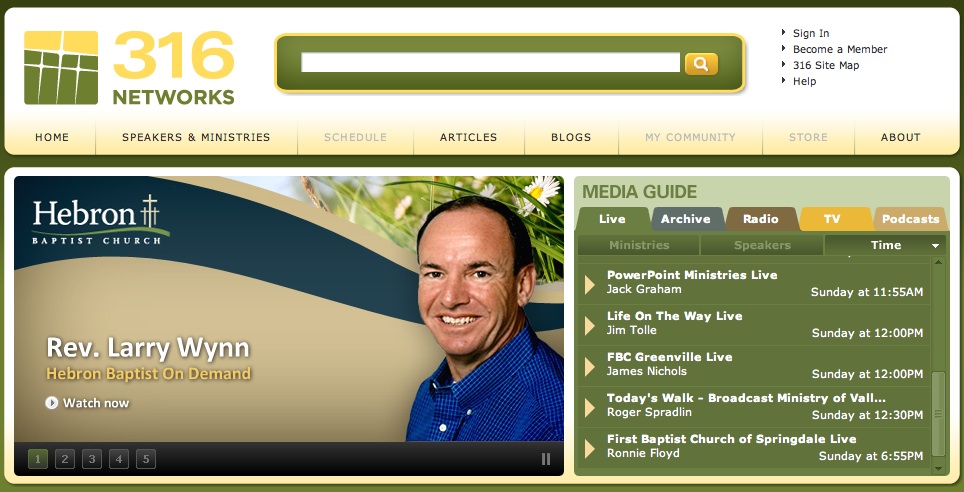Churches and ministries are adopting the use of new technologies to reach the world for Christ. As broadband access increases and more mobile devices are rolled out, expect to see more innovation in how outreach ministry is carried out.

We begin Part 2 of our interview with Chance Mason, President of Streaming Faith and 316 Networks, by asking about the future of Christian broadcasting. (The following interview has been edited for clarity and length.)
Gordon Marcy: Given the shift in technology, what do you think the future is for traditional Christian broadcasting?
Chance Mason: The economic climate and shift in technology to new media has caused radio and television to hunker down; to start focusing on their long-term strategy.
There will always be a need for national television stations. I don’t think that goes away over time. Regional low power stations may begin to get squeezed out. At a minimum, they’ll need a different operational model.
Radio reminds me of dial-up Internet. We think dial-up is dead, but there are still millions of subscribers. Radio still has millions of listeners. It is still a financially profitable model. It will have its place, but it will likely become much less important in the lives of the next generation. It could take up to 30 years for radio to complete its transition to new technology.
In the meantime, the broadcasting industry is going to be challenged. The value of stations is falling and it’s getting tougher to get the advertising dollars they’ve been used to.
Look at how NBC is monetizing Jay Leno’s experience. One minute Jay is in show mode and the next minute he’s pitching the value proposition of a new car. Without moves like this, people are channel surfing away during commercial breaks.
Traditional Christian radio and television networks will have to become more creative…at how they keep their audiences and package opportunities for customers to interact with them.
GM: What’s been the defining moment so far in your organization’s history?
CM: Up to now, leadership and outreach events, like Willow Creek’s Leadership Summit, have been broadcast by satellite. In that model, a live event is pushed up to a bird and deployed to, usually a couple hundred, satellite sites around the country, where attendees have been invited to view the programming. Sometimes the event is seen live, but it can also be tape delayed 1 or 2 hours because of time zone differences.
In April, we were the online multimedia provider for Dave Ramsey’s Town Hall for Hope. LifeChurch.tv in Oklahoma hosted Dave speaking live and we distributed the event to locations via the Internet. We expected about 400-500 churches to participate.
When it was all over, more than 6,000 locations pulled down the broadcast and it was seen by more than 1.4 million people, making it one of the most viewed live Net events in history. No satellite was used and the cost was so much lower.
We had no clue it was going to turn out like that. The model is changing.
GM: Social Media seems here to stay. Where do you think that technology is going?
CM: Online services like Twitter and Facebook are enabling people to tell family and friends-anywhere in the world-that they can participate in a church service or hear a message that has had an impact on their life. There’s no source more trusted than a friend telling you, “This is something I believe in; this is something I’m participating in, and I would encourage you to be a part of it.” There’s nothing more powerful than that. I don’t care how much you advertise, how many billboards you buy, how many ads you put in the newspaper or whatever.
Word of mouth use to be the best way to let people know they needed to hear the gospel. Now social media is the new word of mouth. If churches will leverage new media, we can grow the size of our churches to levels never believed possible.
GM: What does the perfect fulfillment of God’s vision for Streaming Faith and 316 Networks look like?
CM: We want to offer cost-effective solutions to ministries so they can leverage the Internet, distribute their assets and spread the gospel.
Many broadcast ministries are stuck with a model that should have already been changed. Now we’re paying extraordinary costs to get distribution, on television for example. It’s us and the infomercial market paying these astronomical costs.
The secular world looks at us like we’re an infomercial, which is sad. We’re delivering the gospel of Jesus Christ and they think we’re the Ab Workout.
The transition in media that’s underway now, however, is different. I believe the church is ahead of the curve this time, more progressive than many secular organizations. I’ve had major media companies contact me to say they’re amazed that we’ve been able to build a B2B business with a B2C component and be profitable. The HGTV’s, and Food Networks of the world are still trying to figure out how to develop a profitable online media strategy.
I think this is because God has His hand on us. He’s given us direction on what we should pursue and what we should develop. Now we’re able to take that and empower churches to leverage technology; not fear it and not have to pay such a premium.
GM: Thank you Chance, for taking the time to speak with us. We are living in historic times for church communications and you’re on the front lines. God’s continued blessings on you and your team.